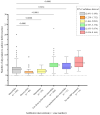Post-COVID-19 Pandemic Rebound of Macrolide-Resistant Mycoplasma pneumoniae Infection: A Descriptive Study
- PMID: 38534697
- PMCID: PMC10967482
- DOI: 10.3390/antibiotics13030262
Post-COVID-19 Pandemic Rebound of Macrolide-Resistant Mycoplasma pneumoniae Infection: A Descriptive Study
Abstract
The rebound characteristics of respiratory infections after lifting pandemic control measures were uncertain. From January to November 2023, patients presenting at a teaching hospital were tested for common respiratory viruses and Mycoplasma pneumoniae using a combination of antigen, nucleic acid amplification, and targeted next-generation sequencing (tNGS) tests. The number and rate of positive tests per month, clinical and microbiological characteristics were analyzed. A rapid rebound of SARS-CoV-2 was followed by a slower rebound of M. pneumoniae, with an interval of 5 months between their peaks. The hospitalization rate was higher, with infections caused by respiratory viruses compared to M. pneumoniae. Though the pediatric hospitalization rate of respiratory viruses (66.1%) was higher than that of M. pneumoniae (34.0%), the 4094 cases of M. pneumoniae within 6 months posed a huge burden on healthcare services. Multivariate analysis revealed that M. pneumoniae-infected adults had more fatigue, comorbidities, and higher serum C-reactive protein, whereas children had a higher incidence of other respiratory pathogens detected by tNGS or pathogen-specific PCR, fever, and were more likely to be female. A total of 85% of M. pneumoniae-positive specimens had mutations detected at the 23rRNA gene, with 99.7% showing A2063G mutation. Days to defervescence were longer in those not treated by effective antibiotics and those requiring a change in antibiotic treatment. A delayed but significant rebound of M. pneumoniae was observed after the complete relaxation of pandemic control measures. No unusual, unexplained, or unresponsive cases of respiratory infections which warrant further investigation were identified.
Keywords: Mycoplasma pneumoniae; macrolide resistance; pandemic; post-COVID-19.
Conflict of interest statement
The authors declare no conflict of interest.
Figures


References
-
- Cheng V.C., Wong S.C., So S.Y., Chen J.H., Chau P.H., Au A.K., Chiu K.H., Li X., Ip P., Chuang V.W., et al. Decreased Antibiotic Consumption Coincided with Reduction in Bacteremia Caused by Bacterial Species with Respiratory Transmission Potential during the COVID-19 Pandemic. Antibiotics. 2022;11:746. doi: 10.3390/antibiotics11060746. - DOI - PMC - PubMed
Grants and funding
LinkOut - more resources
Full Text Sources
Medical
Research Materials
Miscellaneous

